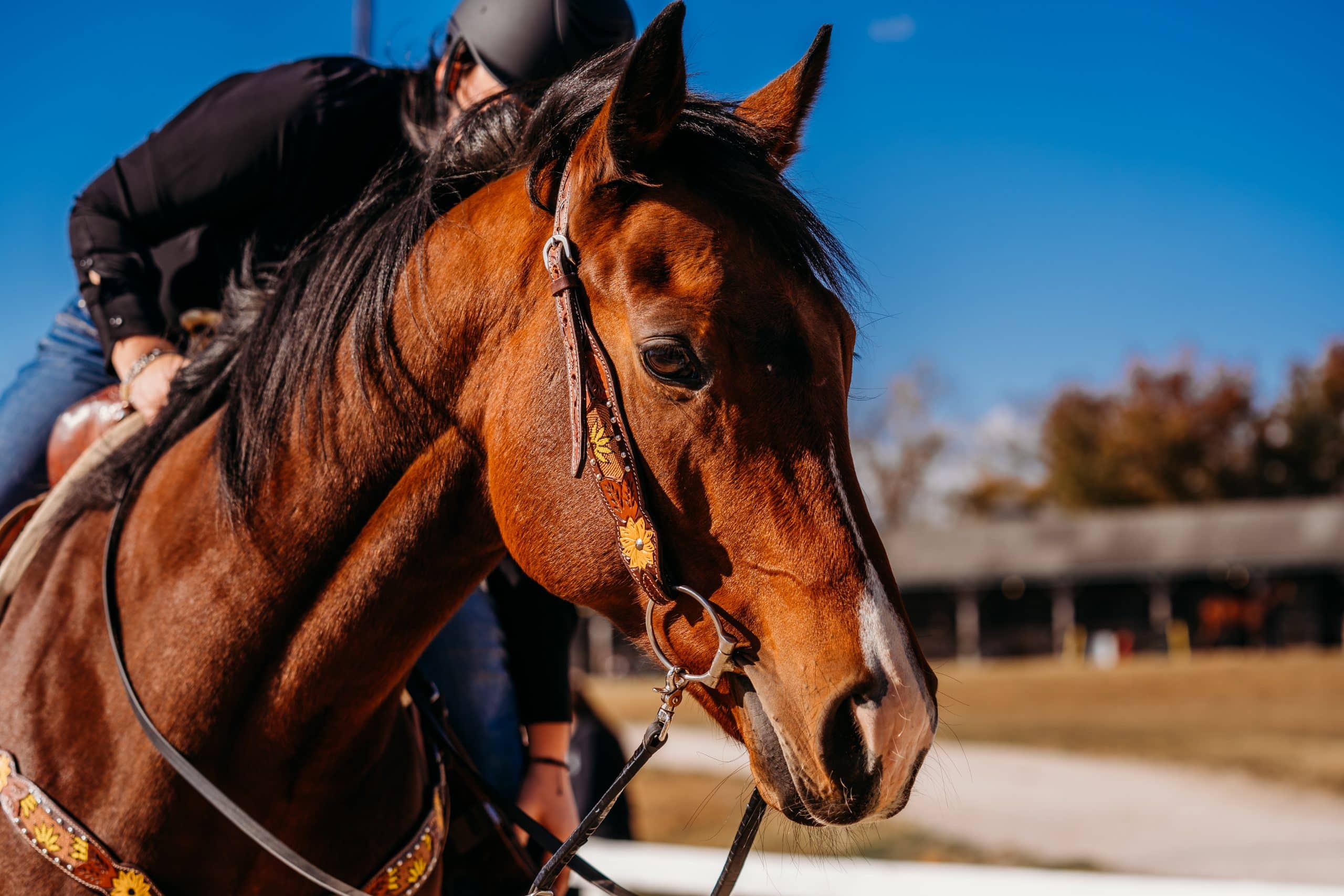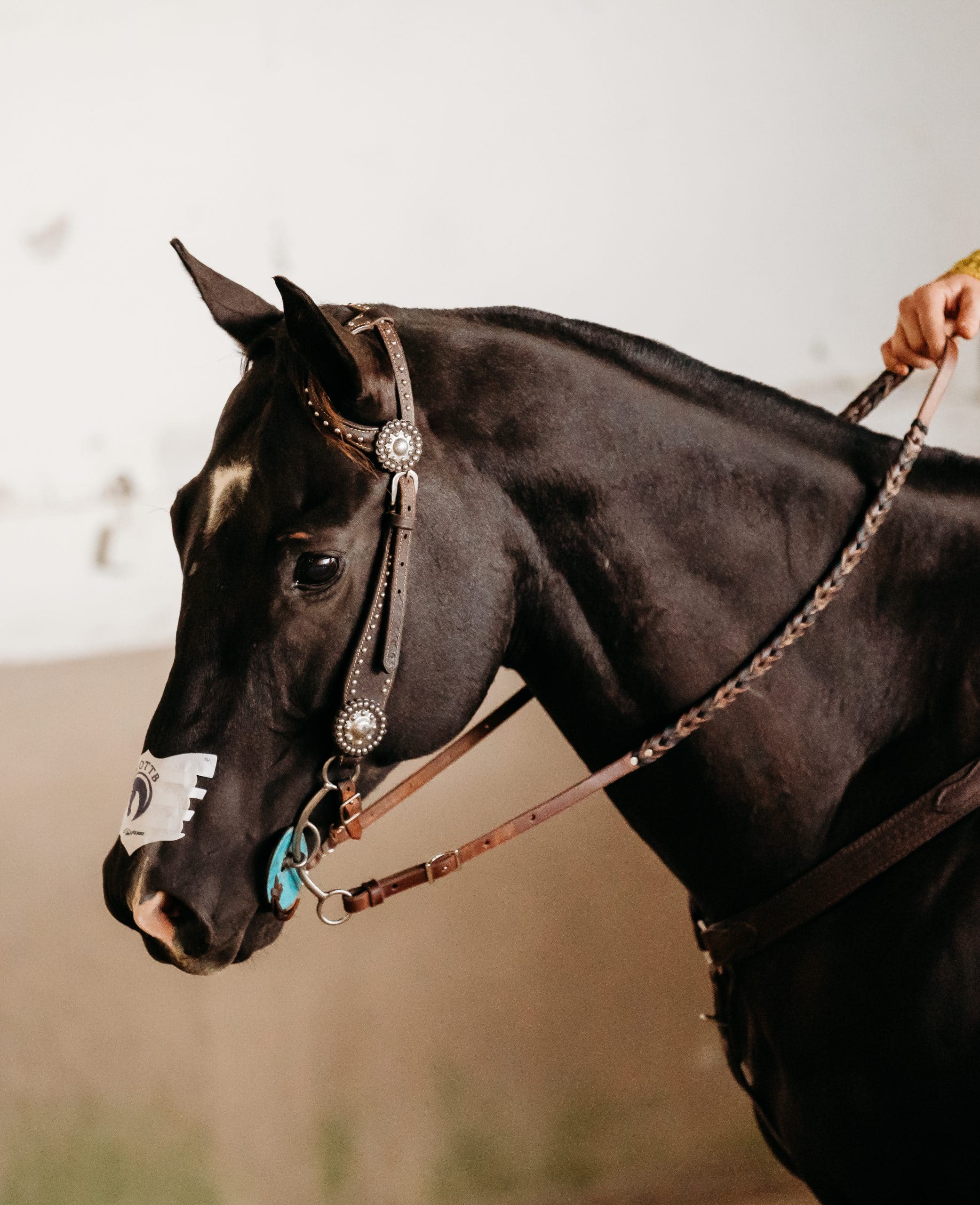
Photo by Captivation Photography
There are multiple lines of communication between the rider and the horse. Each works in tandem with the others for a successful ride. The rider’s hands work with the reins, and the reins work the bit. The bit reinforces the rider’s cues by applying pressure in the mouth — more specifically to the tongue and hard palate — and in some cases leverage to other parts of the horse’s head. The bit also helps control the speed and direction the horse is moving.
Choosing the right bit for your off-track Thoroughbred is important. There are countless bits on the market, and each one has the potential for a different effect on your horse.
Racehorses are trained to run into the bit, so one of the first steps to retraining your OTTB is to recondition his reaction to a bit in his mouth.
“These horses have the tendency to move into the pressure of the bit,” says Clare Mansmann. “But we want them to move toward the hand into the bridle with elasticity eventually.”
Mansmann and her husband, Tom, rode racehorses on the track — Tom was a steeplechase rider and Clare an exercise rider for flat racing. Now, the pair runs Pacific Farms, in Hume, Virginia, where they offer riding lessons for a variety of disciplines as well as training, including restarting off-track Thoroughbreds.
“We start doing groundwork with our horses using rope halters because they offer the best feeling when teaching pressure and moving off the pressure,” explains Mansmann. “Once they understand nose pressure, oftentimes I’ll just start working them in the saddle using the rope halter before we start using a bit.”
Mansmann and other trainers stress the importance of a solid foundation starting on the ground when training horses — whether they’re off the track or not. It’s a good reminder that horses are not born naturally understanding that they should soften to the pull on their mouths; it’s a language they learn with time.
When it comes to selecting the right bit, you must consider several factors, including discipline, rider experience and ability and horse experience and ability. However, it’s important to note: Whatever bit you choose (or should you decide to go bitless), it’s only as effective as your own ability to train and ride your horse.
Bits 101
Bits are most commonly divided into two groups: snaffles and curbs. Kylee Duberstein, PhD, associate professor of equine science at the University of Georgia, says a misconception is that snaffles are bits with broken mouthpieces while curbs are bits with one-piece mouthpieces.
“This is not true,” she says. “The main concept to understand about a snaffle bit is that it applies pressure directly on the mouth of the horse: You pull back on the reins, and the pressure is felt somewhere in the mouth of the horse. That pressure could be felt on the lips, tongue or bars (the space between the incisors and molars where the bit lies) of the horse. This is because the reins attach freely to the bit at roughly the same level as the mouthpiece.”
In fact, if the reins connect directly to the mouthpiece, the bit is a snaffle. In short, snaffles can have a solid or a “broken” mouthpiece (one- or two-piece) or even multiple links, such as a chain. They can also feature a port, a dog-bone shape or rings for the horse to move with his tongue.
On the other hand, a curb bit typically has shanks that employ leverage to apply pressure on the horse’s poll. With a curb, Duberstein explains, the reins and headstall attach to fixed points above and below the level of the mouthpiece. When the rider pulls on the reins, the top of the bit where the cheek pieces are attached rotates forward as the bottom rotates back toward the rider’s hands. This creates a downward pull on the cheek pieces and, thus, the crownpiece of the bridle.
Curb bits require a curb strap of some type (small, linked chains or a leather strap) that runs under the horse’s chin and limits the bit’s degree of rotation. The curb strap works in partnership with the mouthpiece — the pull of the reins applies pressure to the horse’s mouth, chin and poll.
Other bits, such as the pelham, attempt to combine the action of a snaffle and a curb.
“There is a tremendous variety of bits on the market, which can cause a lot of confusion,” says Duberstein. “Different mouthpieces and styles of bits apply pressure differently in the mouth of the horse. It is important to recognize these differences so you can better pick a bit that suits your horse.”

The longer a bit’s shank, the more leverage between the rider and the mouthpiece. Photo by Captivation Photography
Common Snaffle Bits
The shape of a bit’s mouthpiece has a direct effect on where the pressure is applied in the mouth. Mouthpieces that are broken in one location place more pressure on the bars of the mouth. Mouthpieces that are broken in more than one location (i.e., French links or dog bones) shape around the tongue and distribute pressure more equally over the tongue and the bars of the mouth. Mouthpieces that feature a roller, or barrel-hinge, in the middle offer a limited range of motion.
Snaffles with broken mouthpieces include:
■ Loose Ring: Free moving rings, so the mouthpiece moves around in the mouth.
■ Eggbutt: Fixed-ring that is slightly oval in shape and provides consistent contact.
■ Full-Cheek: “Cheeks” protrude from the top and bottom of each ring and reinforce turning aids by applying pressure on the sides of the mouth and will not pull through the mouth.
■ D-Ring: Fixed-ring that does not rotate in the mouth. Offers some of the training benefit of the full-cheek without the safety issues that can come from an upper cheek not secured with keepers to the cheekpiece.
■ French Link: Double-jointed bit applies gentle pressure on the tongue and bars.
■ Rubber: The metal of the mouthpiece is encased in rubber (or the mouthpiece itself is made of rubber).
■ Roller: Double-jointed bit that features a piece of oval metal in the middle.
Snaffle bits featuring solid mouthpieces place more pressure on the horse’s tongue. If a bit features just a solid, straight mouthpiece, it applies pressure on the middle of the tongue.
Common Curb Bits
When deciding on a curb bit, besides choosing the type and size of the mouthpiece, you must also select an appropriate length and type of shank. Shanks can either be solid or have a swivel at the mouthpiece. A shank can be straight (which gives a quicker reaction), have a gentle sweep, a more acute sweep, be shaped like the number seven, or shaped in an S or a variety of patterns. Shank lengths can vary from 4 to 8 inches. The longer the shank, the more leverage between the rider and the mouthpiece.
So Which Bit Is Best?
The best bit for your horse is the one he’s most comfortable in. When Mansmann starts her horses using a rope halter, she observes how the horse reacts by watching his mouth. Does he chew without anything in his mouth like he’s stressed or anxious? If so, you might see him relax after a while and stop chewing. Does he lick his lips and keep a quiet mouth? If so, he’s already relaxed and is processing your asks.
Mansmann says she doesn’t have a formula for choosing to place a particular bit in the horse’s mouth for the first time but has had a lot of success with eggbutt and French link snaffle bits. “It’s not because I think that bit is the absolute best, but because it seems to sit comfortably in their mouth … which is a very good starting place,” she says.
She assesses if a horse is comfortable with a bit by placing it in the mouth with a loose noseband and observing how he reacts. If the horse is happy with the bit sitting in his mouth without a rider on his back, that’s the bit she uses. If he does not accept the bit happily, Mansmann says she might try a rubber bit such as a nathe.
“I also have had horses quite like the Neue Schule Turtle Top,” a double-jointed bit she says aligns well with the anatomy of a horse’s mouth.
But what if the horse exhibits issues upon riding? “If you add the rider, and the horse starts to react with his mouth, such as chewing or gaping, then you know it’s a rider issue, not a bit issue,” says Mansmann. “It’s not particularly that the rider is doing anything wrong, it’s just that the horse is anxious about what’s going to happen next. Then we work through that.”
She says she likes to get horses moving forward and off her leg first, before riding them into the bridle. “I will not use leverage early on, but will for horses much further along in training,” she adds.

Bitless bridles can provide leverage action similar to curb bits if the reins attach to a shank that rotates when rein pressure is applied. Photo by Captivation Photography
Measuring for a Bit
You can easily measure for a bit on your own, but if you’re having difficulty with your horse accepting or working in a bit, you might want to consider having a professional bit fitter work with you (after, of course, you consult your veterinarian to be sure nothing is awry with his dentition).
To measure your horse for a bit, you can use a piece of string (baling twine works, as well). Place the string in your horse’s mouth where the bit typically rests — be sure you’re holding onto both ends of the string. Make note of where your thumbs are on each side of the horse’s mouth, then remove the string. Mark the placement of your thumbs, then measure between those two points.
The bit should stick no further than one-half inch out of either side of the horse’s mouth.
Take-Home Message
If you have questions about the type of bit to use with your OTTB, work with a trainer to discuss your options. Seek guidance from professionals in your chosen discipline. It’s OK to start slow and change bits around, but take your time working with your horse before assuming an issue is bit-related.
Also consider your riding: The piece of metal in the horse’s mouth is important, but so is how you use your hands. Heavy hands can cause issues with even the gentlest bit. And, as Mansmann says, keep it simple.
“Don’t overcomplicate things,” she says. “Later in life you can complicate, but at this stage, and for the first few years of their new career, let them be weird.”
3 Points for the Inside of the Mouth
Before beginning training, it’s imperative you know your horse’s mouth is in shape to accept any type of bit:
- Have your veterinarian perform a health check on your horse, including a dental work-up. If your horse’s teeth have not been routinely cared for, the irregular edges, sharp points and an uneven bite can have a negative effect on your training, no matter the bit you choose. A horse’s teeth should be checked at least once a year as part of their yearly exam alongside routine vaccinations.
- Assess your horse’s mouth and teeth regularly between vet visits, as well. Ulcers and injuries to the mouth can happen at any time and have a big impact on a horse’s performance in the bridle.
- Consider the conformation of your horse’s mouth. Duberstein says some horses with shallow palates are more comfortable with bits that conform around their mouth.
Going Bitless
Some trainers prefer a bitless bridle, either because of physical mouth issues or ridden behaviors. It’s important, however, to understand their different types, how they work and that not every bitless bridle is a “gentler” bridle.
“Bitless bridles apply pressure to the horse’s nose, which can have the advantage of mimicking pressure from a halter (a stimulus most riding horses already know),” says Kylee Duberstein, PhD, associate professor of equine science at the University of Georgia. The location of the rein attachment influences how pressure is applied to the horse. “Reins that attach more laterally (to the sides of the horse’s face) may provide the most lateral steering pressure for teaching horses to turn in response to rein pressure,” she explains.
Bitless bridles can also provide leverage action similar to curb bits if the reins attach to a shank that rotates when rein pressure is applied. “This would provide poll pressure as well as pressure under the chin of the horse (if it has a curb strap), and the rider needs to recognize this difference when using a bitless bridle with leverage,” Duberstein says.

